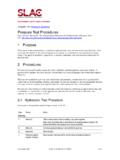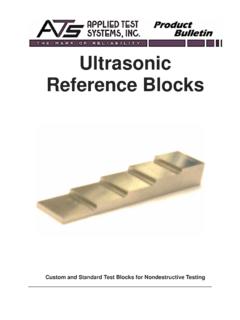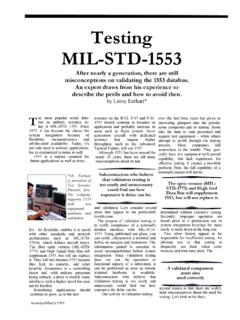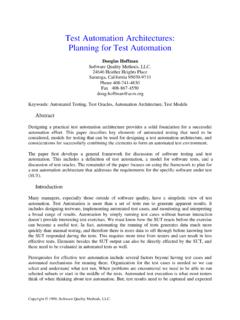Transcription of BOND-TEST - GERMANN | Test Smart
1 BOND-TEST 15 Purpose The BOND-TEST is used to conduct a pull-off test in accordance with ASTM C1583, "Test Method for Tensile Strength of Concrete Surfaces and the bond Strength or Tensile Strength of Concrete Repair and Overlay Materials by Direct Tension (Pull-off Method)." The obtained pull-off strengthcan be used for the following purposes: To evaluate the in-place bond strength between a repair overlay and the substrate To evaluate the in-place tensile strength of concrete or other materials To evaluate the effect of surface preparation procedures on the tensile strength of the substrate before applying a repair material or overlay To estimate the in-place compressive strength of surface concrete using the following approximate relationship between tensile strength ft (MPa) and compressive strength fc (MPa): 10ctff!
2 Principle In the BOND-TEST , a disc is bonded to a prepared testing surface and the disc is pulled off after a partial core has been cut around the disc (extreme left in following figure). The pull-off force, F, is divided by the cross-sectional area of the partial core to obtain the pull-off strength fp:24pFfd"!where d is the diameter of the partial core. F BOND-TEST (a) Failure in substrate (b) bond failure (c) Failure in overlay The types of failures that can occur in a BOND-TEST are illustrated above. Failure in the substrate (a) indicates that the bond strength is greater than the tensile strength of the substrate. A failure at the interface (b) provides a measure of the tensile bond strength between the overlay and the substrate.
3 A failure in the overlay (c) indicates that the bond strength is greater than the tensile strength of the overlay. During a test, it is very important that negligible bending is introduced to the disc by the loading system. Otherwise, low and erratic test results will be obtained. Failure type (a) is the preferred one, as it shows that the bond strength of the overlay is greater than the tensile strength of the substrate. Note that failure occurs at the weakest link of the composite system, and one cannot predict which type of failure will occur. Only tests results with the same typ of failure should be averaged when computing the average pull-off strength.
4 The nature of the BOND-TEST has been investigated by finite element analyses (see Petersen, , Dahlblom, O. and Worters, P., BOND-TEST of Concrete and Overlays, Proceedings,International Conference on NDT in Civil Engineering, University of Liverpool, , 1997). Failure in the BOND-TEST using a 75-mm disc was predicted to occur at a displacement of mm to mm and the nominal stress in the partial core before rupture is about 3 % lower than the uniaxial tensile strength of the substrate concrete. BOND-TEST 16 Variability For 75-mm discs, the coefficient of variation of replicate test results is about 8 to 10 % on concrete with a maximum aggregate size of 38 mm.
5 For 50-mm discs, the coefficient of variation is 14 to 16 %. TheBOND-TEST procedure 1. Surface planing The surface is ground with a diamond wheel to expose the aggregates and to obtain a plane surface. The center knob is removed with a separate grinder. The dry surface is steel brushed and any dust or powder is blown away. The suction plate is used to control the planing operation. Diamond planing wheel unit Electric drill Suction plate Vacuum 2. Bonding the disc A clean disc is bonded to the prepared surface using a rapid-curing adhesive (GRA). The GRA adhesive has a tensile strength of 10 MPa when fully cured, which takes 2 to 5 minutes at normal temperatures.
6 The progress of hardening is observed in the pot in which the two-component GRA was mixed. In cold weather conditions, the concrete surface and the disc are heated with a heat gun to accelerate curing of the adhesive. Vacuum Centering plate 75-mm dia. disc 3. Partial coring A partial core is cut perpendicular to the surface; the bonded disc serves as a drill guide (the inner diameter of the coring bit is slightly larger than the disc diameter). The partial core is cut with theCORECASE (page 28). For tests to measure bond strength, the core is cut to a depth of 25 mm into the substrate or one-half of the core diameter, whichever is greater; for tensile strength of the substrate, cut to a depth of 25 mm.
7 Vacuum Corecase housing Water in Waste water out To spindle assembly and drill4. Pull-off The disc is loaded in direct tension at a controlled rate using a calibrated hydraulic pull machine. The machine bears against a circular counter pressure ring positioned centrally on the planed surface. The peak force in kN is recorded and used to obtain the pull-off strength by dividing by the cross-sectional area of the partial core. The type of failure, (a), (b) or (c), as shown on the previous page, is recorded. Counter pressure ring Centering disc Bearing ring of pull machinePull bolt w/ spherical end Pull off load measured by gage The procedure and the special equipment used for the BOND-TEST ensure that the disc is loaded in direct tension without bending.
8 Such bending may lower results by 20 to 50 %. The discs have sufficient stiffness to avoid distortion during testing. By bonding a clean disc on a planed, dry surface with the GRA adhesive, failure should not occur at the disc/overlay interface. Failure at the disc/overlay interface is an invalid test and must be repeated if the bond strength is to be evaluated. BOND-TEST 17 Testing Examples BOND-TEST being performed for quality control of the bond between a wear resistant overlay and a concrete slab; coring after bonding the 75- mm disc is shown (left), application of pull-off load (middle), and the bond failure, type (b), between the overlay and the substrate (right) at MPa BOND-TEST being performed on granite tiles in a subway station The bond of a repair on a balcony being evaluated with bond -TESTBOND-TEST 18 TheBOND-TEST Equipment and Ordering Numbers B-10000 DSV-Kit: For surface planing, bonding the disc, and attaching the coring rig to produce the partial core without anchoring.
9 ItemOrder #Diamond planing wheel unit B-10010 Suction plate with valve and gauge B-10020 Two adjustable clamping pliers B-10030 Centering plate for 75 mm disc Optionally, centering plate for 50 mm disc B-10040 B-10050 Vacuum pump with hose B-10060 Wrench, 17 mm B-10070 Small screwdriver B-10080 Attach case B-10090 B-11000 BOND-TEST Preparation Kit: For removing the center knob after surface planing, cleaning the surface, bonding the discs, and heating the discs in cold weather conditions ItemOrder #Grinder with cup stone B-11010 Heat gun B-11020 Steel brush B-11030 75 mm discs, 6 pcs Optionally, 50 mm discs, 6 pcs B-11040 B-11050 GRA glue, box B-11060 Putty knife B-11070 Araldite epoxy (for acrylic-based materials) B-11080 Attach case B-11090 Optionally:GRA glue, can with kg powder B-11100 GRA liquid, bottle with 200 mL B11110 CORECASE CS-75: For producing the partial core.
10 ItemOrder #Coring rig with coupling CC-10 Handles for coring rig, 3 pcs CC-20 Coring bit, 75 mm x 110 mm CCB-75/110 Water pump with 2 hoses CC-30 Clamping pliers, adjustable, 2 pcs CC-40 Set of anchoring tools, 8 mm CC-50 8 mm expansion anchors, 20 CC-60 Chisel CC-70 Hammer CC-80 Corelifter, 75 mm diameter CC-90 Wrench, 14 mm CC-100 Measuring tape CC-110 Set of spare bearings for coring rig CC-120 Reinforcement locator CC-130 Manual CC-140 Attach case CC-150 BOND-TEST 19B-12000 BOND-TEST Pull Machine Kit ItemOrder #Hydraulic pull machine with analog gauge B-12010 Centering piece B-12020 Coupling L-16 Pull bolt L-17 Bolt handle L-19 Oil refilling cup L-24 Oil refilling bottle L-25 Large screwdriver C-149 Small screwdriver C-157 Calibration table B-12030 Manual B-12040 Attach case B-12050 The hydraulic pull machine comes with a 0 to 25 kN analog dial gauge, with kN least division.









